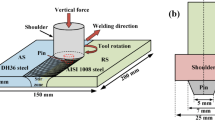Abstract
This work has the objective of evaluating the effect of electromagnetic stirring (EMS) used in continuous ingot (CI) in the mechanical and metallurgical properties of hot forged flanges of AISI 1025 steel. Three conditions of raw material were supplied and compared before the forging process: one from CI using EMS; the other, prevenient from CI without EMS, and the last, with CI without EMS, and, subsequently, submitted to hot rolling process. Billets were extracted from these raw materials to manufacture connection flanges through hot forging. To evaluate the mechanical properties of the forged pieces, tension, hardness and impact tests were done, and the microstructure was observed by optical microscopy. Macrographs and penetrating liquid non-destructive testing were also done. The results of the above-mentioned tests showed proximate mechanical and metallurgical properties approved by the reference norm (ASTM A105) of the flanges manufactured with the raw materials obtained by CI with EMS and hot rolling.














Similar content being viewed by others
References
Hao Y, Lin K, Zhi Z, Haoz S (2006) Morphology and precipitation of kinetics MnS low-carbon steel during thin slab continuous casting process. J Iron Steel Res Int 13:30–36
Garcia A (2001) Solidificação – Fundamentos e Aplicações. editora da Unicamp, Campinas
Silva A, Costa e Silva L, Mei PR (2006) Aços e Ligas Especiais. Editora Blucher, São Paulo
Lee Y, Lee S, Tyne C, Joo B, Moon Y (2011) Internal void closure during the forging of large cast ingots using a simulation approach. J Mater Process Technol 211:1136–1145
Chen K, Yang Y, Shao G, Liu K (2012) Strain function analysis method for void closure in the forgin process of the large-sized steel ingot. Comput Mater Sci 51:72–77
Li BQ (1998) Solidification processing of material in magnetic fields. JOM 50, N°2
Kim G, Kim H, Oh K, Park J, Jeong H (2003) Level meter for the electromagnetic continuous casting of steel billet. ISIJ Int 1998:224–229
Yin Z, Gong Y, Lin B, Cheng YF, Liang D, Zhai Q (2012) Refining of pure aluminum cast structure by surface pulsed magneto-oscillation. J Mater Process Technol 212:2629–2634
Song L, Hui L, Tao Q, Ying W, Pei Z (2011) Control of equiaxed crystal ratio of high carbon steel billets by circular seam cooling nozzle. J Iron Steel Res 18(Issue 2):24–30
Mappeli C, Gruttadauria A, Peroni M (2010) Application of electromagnetic stirring for the homogenization of aluminium billet cast in a semi-continuous machine. J Mater Process Technol 10:306–314
Kumar A, Dutta P (2006) A scaling analysis of alloy solidification in presence of electromagnetic stirring. J Phys D Appl Phys 39:3058–3066
Lin S, Lee W, Chen J (2009) Developing a hot-mode experimental apparatus for property investigations of electromagnetic stirring system. China Steel Corporation (CSC) - IEEE
Hao D, Yan H, Zhao X, Zhu Z, Zhong J (2003) The principle and technology of electromagnetic roll casting. J Mater Process Technol 138:605–609
Xiong B, Cai C, Wan H, Lu B (2011) Fabrication of high chromium cast iron and medium carbon steel bimetal by liquid–solid casting in electromagnetic induction field. Mater Des 32:2978–2982
Campanharo V (2003) Análise térmica do molde de lingotamento contínuo de tarugos – Dissertação de mestrado – rede temática em Engenharia dos Materiais
Cheng J, Xu B, Liang X, Wu Y, Liu Z (1998) Effect of electromagnetic stirring on the microstructure and wear behavior of iron-based composite coatings. J Univ Sci Technol Beijing-Mater 50(Issue 2):451–456
Trindade L (2002) Modelo matemático de um agitador eletromagnético. Dissertação de Doutorado. Universidade Federal do Rio Grande do Sul. PPGEM
Szajnar J, Stawarz M, Wrobel T, Sebzda W (2009) Influence of electromagnetic field on pure metals and alloys structure. J Achiev Mater Manuf Eng 34:95–102
Wróbel T, Szajnar J (2013) Modification of pure Al and AlSi2 alloy primary structure with use of electromagnetic stirring method. Arch Metall Mater 58(3):941–944
Wróbel T (2012) The influence of inoculation type on structure of pure aluminum, Materials of 21st International Conference on Metallurgy and Materials METAL, 23–25.05.2012 in Brno, Czech Republic, pp. 1114–1120
Li H, Zhu M (2009) Effect of electromagnetic stirring in mold on the macroscopic quality of high carbon steel billet. Acta Mettal Sin (Engl Lett) 22(Issue 2):461–467
Chen X-r, Zhang Z-f, Xu J (2010) Effects of annular electromagnetic stirring processing parameters on semi-solid slurry production. Trans Nonferrous Metals Soc China 20:873–877
Li DJ, Hong JS, Kang IS (2012) Numerical analysis on the enhancement of molten steel stirring by magnetic field strength control. Comput Fluids 70:13–20
Qing S, Jin X, Lei Z, Jie G, Zhi F (2010) Effect of electromagnetic force on melt induced by traveling magnetic field. Trans Nonferrous Metals Soc China 20:662–667
American Society for Testing and Materials (ASTM) (2004) ASTM E165-02: metals test methods and analytical procedures V.03.03
Chastel Y, Caillet Y, Caillet N, Bouchard N, Bouchard PO (2006) Quantitative analysis of the impact of forging operations on fatigue properties of steel components. J Mater Process Technol 177:202–205
Milesi M, Chastel Y, Bernacki M, Logé N, Bouchard PO (2010) A multi-scale approach for high cycle anisotropic fatigue resistance: application to forged components. Mater Sci Eng A 527:4654–4663
Milese M, Chastel Y, Hachem E, Bernacki M, Logé R, Bouchard P (2010) A multi-scale approach for high cycle anisotropic fatigue resistance application to forged components. Mater Sci Eng A 527:4654–4663
Acknowledgments
The authors gratefully acknowledge LdTM/UFRGS and SENAI CIMATEC for the support in the development of these studies.
Author information
Authors and Affiliations
Corresponding author
Rights and permissions
About this article
Cite this article
Yurgel, C.C., Lora, F.A., de Oliveira, C.A.S. et al. Effect of using eletromagnetic stirring on AISI 1025 steel forged flanges. Int J Mater Form 8, 119–126 (2015). https://doi.org/10.1007/s12289-013-1153-8
Received:
Accepted:
Published:
Issue Date:
DOI: https://doi.org/10.1007/s12289-013-1153-8




